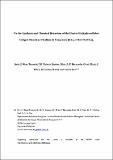Please use this identifier to cite or link to this item:
http://hdl.handle.net/10261/57973Share/Export:
 SHARE SHARE
 CORE
BASE CORE
BASE
|
|
| Visualizar otros formatos: MARC | Dublin Core | RDF | ORE | MODS | METS | DIDL | DATACITE | |

| Title: | On the Synthesis and Chemical Behaviour of the Elusive Bis(hydrosulfido)-Bridged Dinuclear Rhodium(I) Complexes [{Rh(μ-SH)(CO)(PR3)}2] |
Authors: | Pérez-Torrente, Jesús J. CSIC ORCID; Jiménez, M. Victoria CSIC ORCID ; Hernandez-Gruel, Marc A. F.; Fabra-Caro, María J.; Lahoz, Fernando J. CSIC ORCID; Oro, Luis A. CSIC ORCID | Keywords: | Bridging ligands Clusters compounds Rhodium Sulfur |
Issue Date: | Nov-2009 | Publisher: | Wiley-VCH | Citation: | Chemistry - A European Journal 15(45): 12212-12222 (2009) | Abstract: | Several bis(hydrosulfido)-bridged dinuclear rhodium(I) compounds, [{Rh(μ-SH)(L)2}2], have been prepared from rhodium(I) acetylacetonato complexes, [Rh(acac)(L)2], and H2S(g). Reaction of [Rh(acac){P(OPh)3}2] with H2S(g) affords the dinuclear bis(hydrosulfido)-bridged compound [{Rh(μ-SH){P(OPh)3}2}2] (1). However, reaction of complexes [Rh(acac)(CO)(PR3)] with H2S(g) gives the dinuclear compound [{Rh(μ-SH)(CO)(PR3)}2] (R=Cy, 2; R=Ph, 4) and the trinuclear cluster [Rh3(μ-H)(μ3-S)2(CO)3(PR3)3] (R=Cy, 3; R=Ph, 5). The selective synthesis of both type of compounds has been carried out by control of the H2S(g) concentration in the reaction media. The trinuclear hydrido–sulfido cluster [Rh3(μ-H)(μ3-S)2(CO)3(PPh3)3] (5) has been also obtained by reaction of [{Rh(μ-SH)(CO)(PPh3)}2] (4) with [Rh(acac)(CO)(PPh3)], proceeding through the trinuclear hydrosulfido–sulfido intermediate [Rh3(μ3-SH)(μ3-S)(CO)3(PPh3)3]. The molecular structures of complexes 1 and 3 have been determined by X-ray diffraction methods. Compound 1 is stable in solution, but complexes 2 and 4 slowly transform in solution into the trinuclear hydrido–sulfido clusters 3 and 5, respectively, with the release of H2S(g) in a reversible way. 1H NMR kinetic experiments for the transformation of 4 into 5 have revealed that this transformation follows second-order-type kinetic. The following activation parameters, ΔH≠=24±3 kJ mol−1 and of ΔS≠=−223±8 J K−1 mol−1, have been calculated from the determination of the second-order rate constants in the temperature range 30–45 °C. The large negative value of the activation entropy is consistent with an associative character of the rate-determining step. A plausible multistep mechanism based on the chemical behaviour of hydrosulfido–metal complexes and compatible with the kinetic behaviour has been proposed. | Description: | 11 páginas, 6 figuras, 5 tablas, 4 esquemas. | Publisher version (URL): | http://dx.doi.org/10.1002/chem.200902249 | URI: | http://hdl.handle.net/10261/57973 | DOI: | 10.1002/chem.200902249 | ISSN: | 0947-6539 | E-ISSN: | 1521-3765 |
| Appears in Collections: | (ICMA) Artículos |
Files in This Item:
| File | Description | Size | Format | |
|---|---|---|---|---|
| Elusive Bis.pdf | 1,75 MB | Adobe PDF |  View/Open |
CORE Recommender
SCOPUSTM
Citations
12
checked on Apr 18, 2024
WEB OF SCIENCETM
Citations
13
checked on Feb 22, 2024
Page view(s)
294
checked on Apr 19, 2024
Download(s)
329
checked on Apr 19, 2024
Google ScholarTM
Check
Altmetric
Altmetric
WARNING: Items in Digital.CSIC are protected by copyright, with all rights reserved, unless otherwise indicated.
